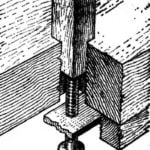 The classification of the European Association of Amateur athletes of ship modeling sport (“NAVIGA”) provides for managed competition models of sailing yachts in three classes: F5-M (“Marblehead”), F5-10 (“Enricher”) and F5-X (free). The design of boat models the first two classes has the names of the first winners of the European competition.
The classification of the European Association of Amateur athletes of ship modeling sport (“NAVIGA”) provides for managed competition models of sailing yachts in three classes: F5-M (“Marblehead”), F5-10 (“Enricher”) and F5-X (free). The design of boat models the first two classes has the names of the first winners of the European competition.
In 1976, our magazine was introduced to lovers of exciting sport with class F5-10 and F5.
The proposed model yachts F5-M built the champion of the USSR, master of sports Clement Golovin from the city of Kazan.
THE BUILD
The hull model consists of two layers of fiberglass and wikiepedia on a wooden disc, made according to the theoretical drawing (Fig. 6, 7). For the inner layer is more suitable stekloreza, and for exterior — fiberglass ass-10 or similar. For vyklicky easier to use epoxy cold curing ED-5, ED-6, and others.
In the treated sandpaper the hull are glued technological frames, the transom balsa or foam and “svartby” well, used to fasten a removable keel with ballast. This piece is cut from baklizia-bath of plywood or similar material with a thickness of 10 mm (see Fig. 7). At the bottom of the keel mounted with screws ballast — two lead plates with a total weight of 2.9 kg.
To install the deck, made from aviation plywood with a thickness of 1.5 mm along the sides for the entire length of the housing on the resin are glued pine stringers cross section 8X8 mm with him fixing screws guys-putenkov glued birch cleats 60Х20Х15 mm. At the median plane of the body cuts and pasted in the technological frames fir lumber size 285X25X10 mm. It is used to fix the screws on the same Board stepping the mast with a swivel grotto-boom and swivel the jib boom.
Mast elliptical shape with the face-groove, which extends in the front part of the cave, glued pine strips (Fig. 5). It rotates freely in the joints of the steps and of the mount of the guys and jib-the forestay (Fig. 1, 2) to the mast.

Fig. 1. The scheme of measurement of the sail and the attachment point guys and jib-the forestay on the mast.

Fig. 2. Node stepping the mast.

Fig. 3. Swivel jib-boom.
The mainsail and the jib boom is made of thin-walled duralumin tubes (see Fig. 7), respectively Ø 10 mm and 8 mm.
The swivel design of the jib-boom, parts stepping the mast, mounting the guys and jib-the forestay on the mast are shown respectively in figures 1-3.
The rudder can be cut along the contour and profile of duralumin plate thickness 9 — 10 mm and glued six layers of aircraft plywood with a thickness of 1.5 mm.
When turning the steering wheel to shift in both directions at 35-40° with the least backlash. Eyelets for wiring mainsail-mainsheet and the jib sheet from the winch drum to boom machined from PTFE or brass and secured to the deck.
Iron snatch-blocks of the jib of the Scots machined from duralumin. Shkotovo winch homemade. The motor type “gnome”. Gear can be rented from the synchronous time electric drives of the type SD-2, SD-2L and SRD-2 with a gear ratio of 1:120.
The sail model is made of nylon fabric sailing DZ (weight of 1 m2 — 61 g ). They can also be sewn from fabric “Bologna”.
To control model yachts uses a dual-channel instrument control.

Fig. 4. Scheme of General arrangement of control elements and actuators:
1 — the grotto-sheet, 2 — metal eyelet in the deck, 3 — car steering, 4 — receiver, 5 — power, 6 — blocks staysail-sheet, 7 — staysail-sheet, 8 — sheet winch.

Fig. 5. The cross section of the mast.

Fig. 6. The projection of “housing”

Fig. 7. The hull yacht model and theoretical drawing.
After painting and assembling the model using lanyards and stays set the mast tilting to the stern at 3-5° relative to the deck, then a change in the length of the Scots of the mainsail and headsail should be on the upwind staysail began to “take the wind” (“zaprashivat”) before the grotto. After this is checked in all the courses, except for the “backstay” and “jibe”. Later model with the steering wheel set in the neutral position, is to slowly square away (i.e. gradually turn the nose against the wind), the staysail should not “blow out” in the grotto, and the “to zaprashivat” too early. When so adjusted, the model will be well managed and to go to the cool wind.
As shown in figure 4, the centers of rotation of the front scatolin of the sails and the axis of rotation of geeks spaced along the length in the diametrical plane. This allows to increase the amount of deflection (“belly”) of the sails during the transition to full courses.
Further adjustment (fine-tuning) manageability of the model is carried out in a joint racing yachts.
The REQUIREMENTS MODEL of CLASS F5-M
Maximum length (Ls) — 1270 ± 6 mm. Not included in the total length of the size of the front fenders, but the last shall not extend more than 12.7 mm.
Breadth, draught, freeboard, displacement and weight of the ballast is not limited.
The transition from shell model to the keel at amidships rounded at a radius less than 25.4 mm.
The thickness of the mast may not exceed 19 mm.
Plates palovich angles at the base not wider than 19 mm.
Sail area without Spinnaker no more 5160,0 cm2.
The height of the jib the forestay above deck not more than 80% of the height of the plates of the head points of a corner of the grotto. The maximum number of lat on the main four, and on the staysail — not more than three. Battens are installed at approximately equal distance from each other. Length lat of the grotto not more than 101.6 mm; headsail — not more than 50.8 mm. Battens are not required.
Round battens are not used.
Not allowed the simultaneous staging of the two caves.
The Spinnaker sail can be put only with the Spinnaker-boom, the length of which shall not exceed 380 mm, if you measure the length from the middle of the mast to knock the Spinnaker-boom. Do not use the Spinnaker pole as a bowsprit and secure it in this position on the deck. It is impossible to fix the Spinnaker above the jib and the forestay to increase its rigidity. Do not allow the jib sheets and Spinnaker-sheets fastened behind the mainsail.
Finally, the rules provide that at the time of the start of the Spinnaker pole should be on the opposite side of the mainsail-boom.
Prohibited: movable keels, the middle side of the zygomatic Shorty, bugspray, protruding above the water rudders, outrigger floats, double, or multi-piece housing, the floating or variable ballast.
Square stances (SC), cm2…………………..1991
The area of the grotto (SG), see2…………………………3112,5
Total sail area (SN), cm2…….5103,5
Displacement (G), g……………………………5200
K. GOLOVIN, master of sports of the USSR



